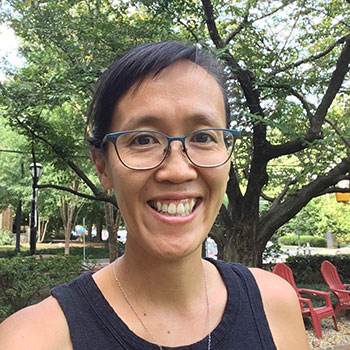- You are here:
- Home
February 1, 2021
The Joint Mathematics Meetings (JMM) is the largest meeting of the year, bringing together researchers and academic professionals from every corner of the country and from every disicpline. Two of the invited speakers were SoM faculty, and one was an SoM alumni.
ASL Invited Address - Anton Bernshteyn
Descriptive combinatorics and distributed algorithms
Saturday January 9, 2021, 9:00 a.m.-9:50 a.m.
Descriptive combinatorics is the study of combinatorial problems (such as graph coloring) under additional topological or measure-theoretic regularity restrictions. It turns out that there is a close relationship between descriptive combinatorics and distributed computing, i.e., the area of computer science concerned with problems that can be solved efficiently by a decentralized network of processors. In this talk, I will outline this relationship and present a number of applications.
Current Events Bulletin Session (Lecture III) - Jennifer Hom
Getting a handle on the Conway knot
Friday January 8, 2021, 3:00 p.m.
When does a knot bound a disk? In three dimensions, the only knot that bounds a smoothly embedded disk is the unknot. However, if one considers disks in the four-ball, the answer becomes significantly more difficult.
A knot is called slice if it bounds a smooth disk in the four-ball. For 50 years, it was unknown whether a certain 11 crossing knot, called the Conway knot, was slice or not, and until recently, this was the only one of the thousands of knots with fewer than 13 crossings whose slice-status remained a mystery. In this talk, we will describe Lisa Piccirillo's proof that the Conway knot is not slice. The main idea of her proof is given in the title of this talk.
AMS Invited Address - Ryan Hynd (MSc 2004)
The Hamilton-Jacobi equation, past and present
Friday January 8, 2021, 10:05 a.m.-10:55 a.m.
Nearly two centuries ago, William Rowan Hamilton observed that the equations of motion in classical mechanics can be derived by finding stationary points of a certain integral. In addition, he identified an equation satisfied by the integral itself, which is now known as the Hamilton-Jacobi equation. These ideas were later expanded upon by scientists who grappled with the challenges of understanding how to regulate machines, control spacecrafts, and optimize the production of goods. In recent years, mathematicians have made tremendous progress in developing a theory of control which prominently features a Hamilton-Jacobi equation. We will discuss the highlights of this theory, some applications, and a few theoretical issues of interest today.



